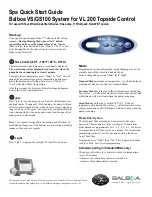
The specified torque loading for the bolts/screws of the end
cables and connectors are detailed in the table below:
NexSys
®
Bloc Type
Standard
Terminal
Terminal
Torque
Terminal
Adapter
Terminal
Torque
Nm
Nm
Ibf
in
Nm Ibf
in
12NXS26
12NXS36
12NXS38
12NXS90
12NXS120
M6
Female
6.8
60
SAE
6.8
60
12NXS61
12NXS85
M6
Female
9.0
80
N/A
12NXS86
3/8 - 16“
Female
6.8
60
SAE
6.8
60
12NXS137
12NXS157
M6
Female
9.0
80
M6 Front
Terminal
9.0
80
12NXS166
12NXS186
M8
Female
9.0
80
M6 Front
Terminal
9.0
80
2. Operation
The nominal operating temperature is 30°C at C
5
/C
6
rate.
The optimum lifetime of the bloc depends on the operating
conditions (temperature and depth of discharge). The ambient
temperature range of use for the bloc is between +5°C and
+45°C, any use outside of this range must be approved by
an EnerSys
®
representative. Optimal bloc life is obtained
with the bloc at a temperature of 25°C – 30°C. Higher
temperatures shorten the life of the bloc, lower temperatures
reduce the available capacity. The upper temperature limit
is +45°C and blocs should not be operated above this
temperature. The capacity of the blocs changes with
temperature and falls considerably under +10°C. The optimum
lifetime of the bloc depends on the operating conditions
(moderate temperature and discharges equal to or lower
than 60% of the nominal capacity C
5
/C
6
). The bloc obtains its
full capacity after about 3 charging and discharging cycles.
2.1 Discharging
The valves on the top of the bloc must not be sealed or
covered.
Electrical connections (i.e. plugs) must only be made or
broken in the open circuit condition. Discharges over 80% of
the rated capacity are categorized as deep discharges and are
not acceptable as they reduce the life of the bloc. Discharged
blocs MUST be recharged immediately and MUST not be left
in a discharged condition.
Note: The following statement only applies to partially
discharged blocs.
Discharged blocs can freeze. Limit the discharge to a
maximum of 80% DOD. The cycle life of the bloc will depend
on the DOD, the higher the DOD, the shorter the cycle life.
The following energy cut-off settings must be used :
• 60% DOD set at 1.96 Volts per cell; or
• 80% DOD set at 1.92 Volts per cell; or
when discharged with currents in the range of I
1
to I
6
.
At lower currents please seek advice from an EnerSys
®
representative.
2.2 Charging
NexSys
®
blocs MUST be charged using an EnerSys approved
specified charger. Failure to do so will affect the performance
and life of the bloc and invalidate any warranty. The specific
charging profile, with High Charging Rates, developed for
recharging the NexSys blocs allows a rapid recharge in
3 hours from 60% DOD and opportunity charging as often as
needed without damaging the blocs.
The NexSys blocs have an extremely low gas emission.
Nevertheless, provisions must be made for venting of the
charging gases. Doors, bloc container, lids and the covers of
battery compartments must be opened or removed. With the
charger switched off, connect the bloc to the charger, ensuring
that the polarity is correct. (Positive to positive, negative to
negative). Now switch the charger ON.
2.3 Equalizing Charge
The EnerSys approved charger includes specific features to
ensure that the bloc remains charged and equalized.
3. Maintenance
The electrolyte is immobilized. The density of the electrolyte
cannot be measured. Never remove the safety valves from the
bloc. In case of accidental damage to the valve, contact your
EnerSys representative for replacement.
3.1 Daily
• Recharge the bloc after every discharge.
• Check the condition of the plugs, cables and make sure
that all insulation covers are in place and are in good
condition.
3.2 Weekly
• Allow up to 6 hours for a full charge at least once per
week.
• Visually inspect for signs of dirt and mechanical damage to
all component parts of the bloc, paying particular attention
to the battery charging plugs and cables.
3.3 Quarterly
At the end of the charge, take end of charge voltage readings,
measure and record:
• The voltage of the complete bloc
• The voltages of each bloc
If significant changes from earlier measurements or differences
between the blocs are found, please contact an EnerSys
representative.
If the run time of the bloc is not sufficient, check the
following:
• That the required work is compatible with the bloc capacity
• The settings of the charger
3.4 Annually
Internal dust removal from the charger.
electrical connections: test all connections (sockets, cables,
and contacts).
Blocs having terminals with insert: check the torque
loading of the bolts/screws. Test the insulation resistance
of the bloc. Insulation resistance of the bloc thus determined
must not be below a value of 50
Ω
. per Volt of nominal
voltage. For blocs up to 20 V nominal voltage the minimum
value is 1000
Ω
.
4. Care of the bloc
The bloc should always be kept clean and dry. Any liquid in the
bloc tray must be extracted and disposed of in the prescribed
manner.
Damage to the insulation of the tray should be repaired after
cleaning to prevent corrosion.





















